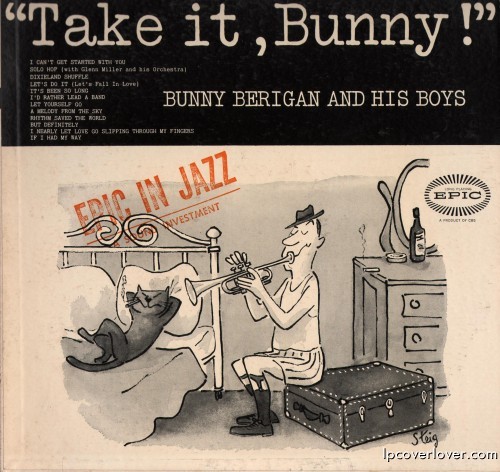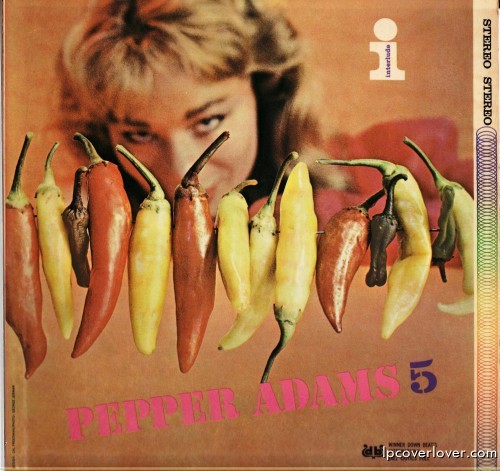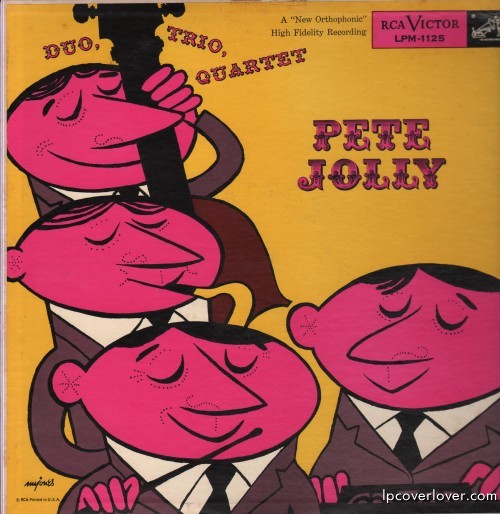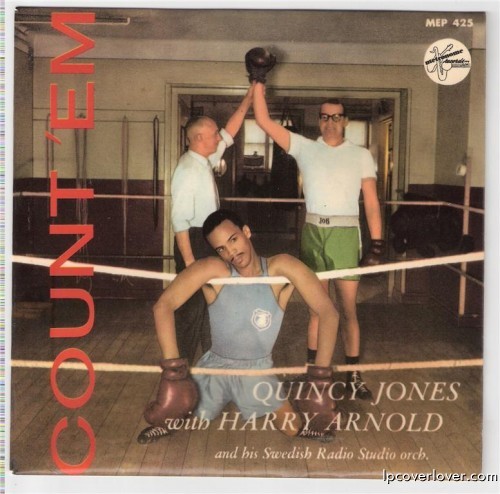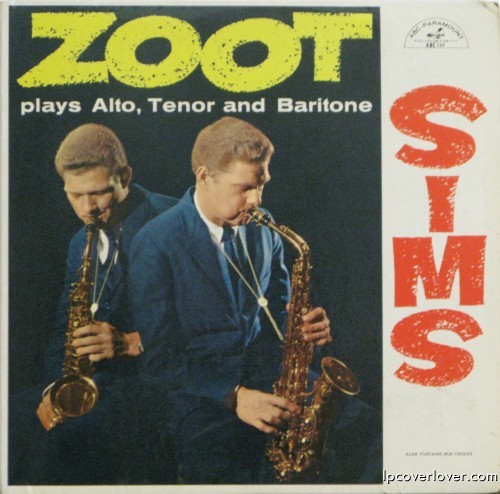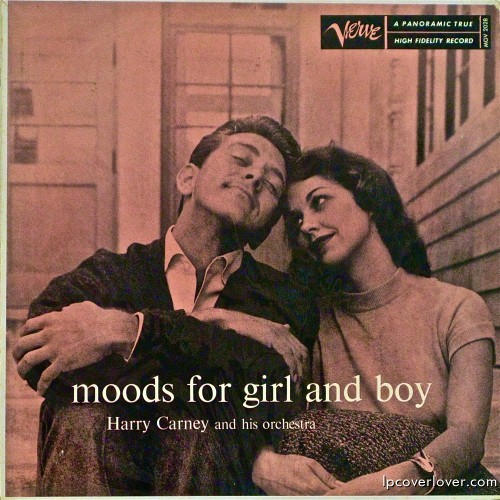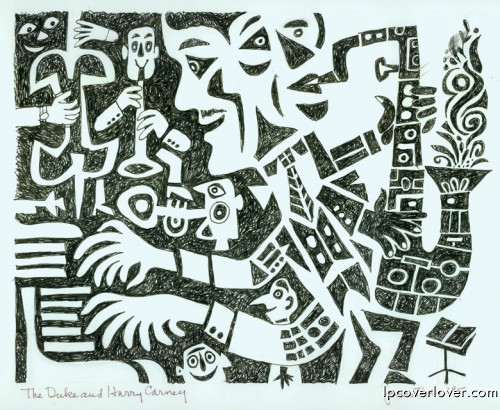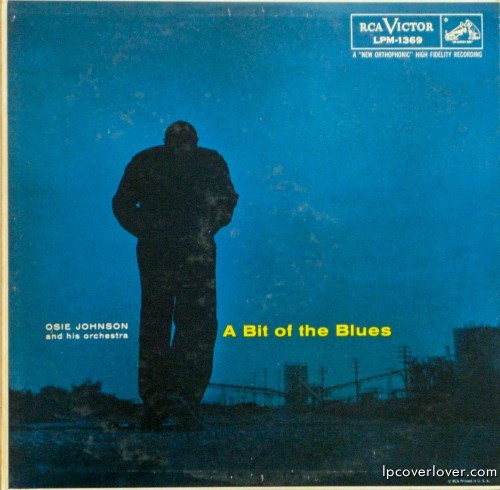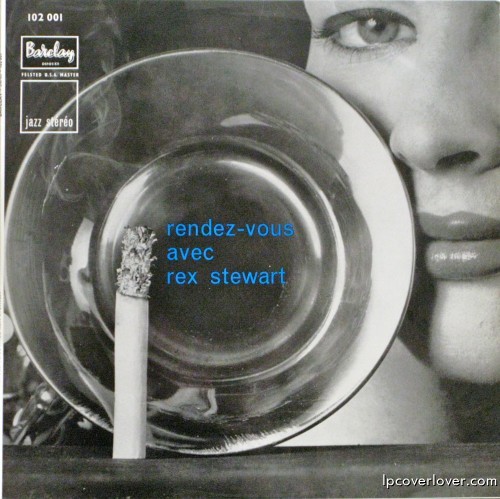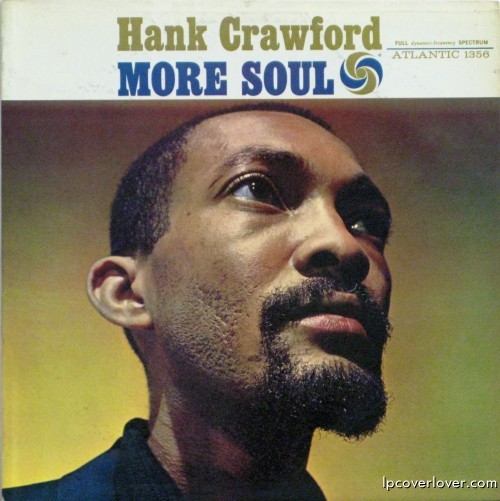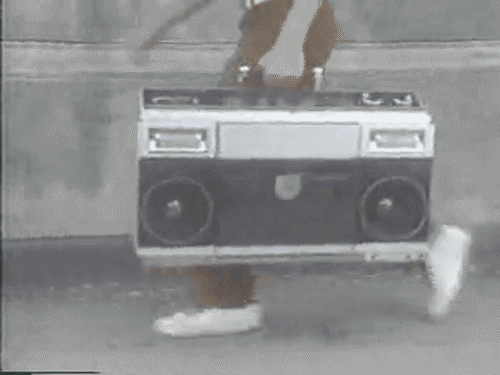Jazz
You are currently browsing the archive for the Jazz category.
The cat in the flat
“Take it, Bunny!” Bunny Berigan and his Boys Epic Records (1960) Drawn from mono 78s Berigan cut in the ’30s. Bunny Berigan’s heavy drinking and fast-paced lifestyle cut his life short in 1942 when he was only 33 years old, and all told, the swing trumpeter’s recorded legacy doesn’t even span a decade. Still, his incredible range on the instrument and his always beautiful tone have given him a deserved spot as one of the greatest trumpet players in the history of jazz. Illustrated by the great New Yorker cartoonist William Steig!
Personnel and Recording Dates
Solo Hop. Recorded: New York April 25, 1935. Glenri Miller and his Orchestra: Bunny Berigan, Charlie Spivak (trumpet), Jack Jenny, Glenn Miller (trombone), Johnny Mince (clarinet and alto.), Eddie Miller (tenor), Claude Thornhill (piano), Larry Hall (guitar), Delmar Kaplan (bass), Ray Bauduc (drums).
It’s Been So Long, I’d Rather Lead A Band, Let Yourself Go. Recorded: New York, February 24, 1936. Bunny Berigan and his Boys. Bunny Berigan (trumpet), Joe Marsala (clarinet and tenor), Forrest Crawford (tenor), Joe Bushkin (piano), Dave Barbour (guitar), Morton Stuhlmaker (bass), Dave Tough (drums).
A Melody From The Sky, I Can’t Get Started, Rhythm Saved The World. Bunny Berigan and His Boys. Bunny Berigan (trumpet), Forrest Crawford (tenor), Artie Shaw (clarinet
in Melody and Started), Paul Ricci (clarinet in Rhythm) Joe Bushkin (piano), Morton Stuhlmaker (bass), Stanley King (drums).
I Nearly Let Love Go Slipping, But Definitely, If I Had My Way. Recorded : New York June 9, 1936. Bunny Berigan and his Boys. Bunny Berigan (trumpet), Jack Lacey (trombone), Slats Long (clarinet), Joe Bushkin (piano), Eddie Condon (guitar), Morton Stuhlmaker (bass), Cozy Cole (drums).
Dixieland Shuffle, Let’s Do It. Recorded: New York, February 17, 1937. Bunny Berigan and his Orchestra, Bunny Berigan, Henry Greenwald, L. Brown (trumpet), Ford Leary (trombone), Matty Matlock (clarinet), Hymie Schertzer (alto.), Art Drelinger (tenor), Les Burness (piano), Tom Morgan (guitar), Arnold Fishkin (bass), Manny Berger (drums).
He comes out swinging!
“Count ‘Em” Quincy Jones with Harry Arnold and his Swedish Radio Studio Orch. Recorded in Stockholm for Metronome Records (1958) A three-song EP with “Count ‘Em”, “Meet Benny Bailey” (featuring the added trumpet of … Benny Bailey) and “Cherokee” These tracks are also on the LP “Quincy’s Home Again”. Q writes in the notes, “The atmosphere, the warmth, the musicianship and the understanding I found in Sweden certainly make me consider it my spiritual home” Consider in contrast what blacks, including many brilliant jazz artists, were experiencing in their native home America in 1958 and why so many became expatriates in Europe for years. Thanks to Lp cover lover, ULF for another fine contribution.
Sims city!
Zoot Sims plays Alto, Tenor and Baritone ABC-Paramount Records (1956) With John Williams (p), Knobby Totah (b), Gus Johnson (d) Music by George Handy. Bob Brookmeyer describes the power of Zoot’s playing: “Zoot plays earthy. He is direct, simple, logical, and above all, emotional”. Here Zoot blows alto, tenor and baritone saxophones in unison, opening and closing passages, and soloing individually on each horn. Dom Cerulli, in his highly enthusiastic review in Down beat, said: “Handy’s writing is as constantly alive and imaginative, as Zoot’s playing is forceful and swinging.”
I remember where I bought this LP as I surprisingly often do when pulling one down from the shelf. Funny that. This one came from the only used record store in Key West on a short trip I took there in 1986. It was on the wall next to a Sun Ra on Saturn that I also picked up that day. Then it was off to Duval street for a beer and Pepe’s for oysters. Sometimes a record can bring it all back.
Moods swing
Harry Carney and his Orchestra “Moods For Girl and Boy” Verve Records (1956) Reissue of Clef MGC 640 entitled “Harry Carney With Strings” (1954) Ray Nance (tp, violin) Tony Miranda (frh) Jimmy Hamilton (cl, ts) Harry Carney (bars, bcl) Leroy Lovett (p) Billy Bauer (g) Wendell Marshall (b) Louis Bellson (d) unidentified strings
Harry Carney (1910 -1974) began his professional musical career at the age of 13, playing clarinet and later the alto and baritone saxophone in Boston bands. Among his childhood friends were Johnny Hodges and Charlie Holmes, with whom he visited New York in 1927. Carney played at the Savoy Ballroom with Fess Williams before joining Duke Ellington, who was about to play in the young musician’s home town. When this engagement was over Carney left for a tour with Ellington, who had taken on the role of guardian. The job with Ellington lasted until Duke’s death 47 years later. Shortly after joining Ellington, Carney was persuaded to play alto saxophone, but soon gravitated to the baritone, an instrument he proceeded to make his own. Carney’s rich sonority became an essential element in Ellington’s tonal palette and for decades listeners gloried in the full-throated lower register which, in a band brimming with individualists, had a character all its own.
Nevertheless, despite his virtuosity on the baritone, Carney would take up the clarinet on frequent occasions to show he was truly a master of the reed instruments. Carney’s relationship with Ellington transcended that of musician and leader; he was Ellington’s confidante and for decades he drove the Duke from gig to gig. The closeness of their relationship was underlined by Carney when he said: ‘It’s not only been an education being with him, but also a great pleasure. At times I’ve been ashamed to take the money.’ After Ellington’s death, at the end of May 1974, Carney said, ‘Without Duke I have nothing to live for.’ He died a little over four months later. – Verve Records Bio
Here’s a Jim Flora drawing from 1995 of The Duke and Harry Carney:
Give the drummer some
“A Bit of the Blues” Osie Johnson and his orchestra RCA Victor Records (1956) Featuring: Osie Johnson (vocal), Nick Travis (tp), Hal McKusick (as, cl), Al Cohn (ts), Milt Hilton (b), Gus Johnson In the 1950s and the first half of the 1960s, Osie Johnson was one of the most in-demand drummers in New York, making a countless number of recordings and working steadily in the studios. Johnson was a member of Earl Hines’ band during 1951-1953. Stints with Dorothy Donegan and Illinois Jacquet followed before he became a busy session musician, playing and recording with a who’s who of mainstream (including Coleman Hawkins, Dinah Washington, Wes Montgomery, and Sonny Stitt). In addition to contributing tasteful and supportive drums, Osie Johnson was an occasional composer, arranger, and singer, leading sessions for Jazztone (1955) and RCA (1956).
Alto ‘tude
Hank Crawford “More Soul” Atlantic Records (1961) Portrait by Lee Friedlander. Along with David “Fathead” Newman, Hank Crawford lead the pre-eminent sax section of Ray Charles classic group of the late 50’s – early 60’s. Crawford, who joined Charles’ band in 1957, primarily held down the role of baritone sax player, but with this recording he’s able to stretch out on the alto. As he often did with Ray Charles, More Soul sees Hank in the role of arranger. The night that this record was cut, I’ve read, Crawford played Harlem’s Apollo theater until 1am, took the short ride down to Broadway and the Atlantic studios and recorded these seven tracks before dawn. Crawford’s arrangements for septet dispense with piano, aside from a little comping by Hank, which vividly opens out the sound of brass and horns, and gives a greater weight and clarity to the bass/drums rhythm section of Edgar Willis and Milt Turner. Fathead Newman plays tenor. The great Tom Dowd engineered. Nesuhi Ertegun produced. Check it out!

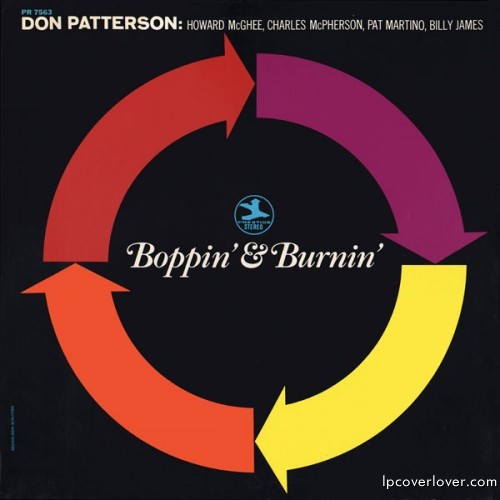


 (44 votes, average: 3.55 out of 5)
(44 votes, average: 3.55 out of 5)